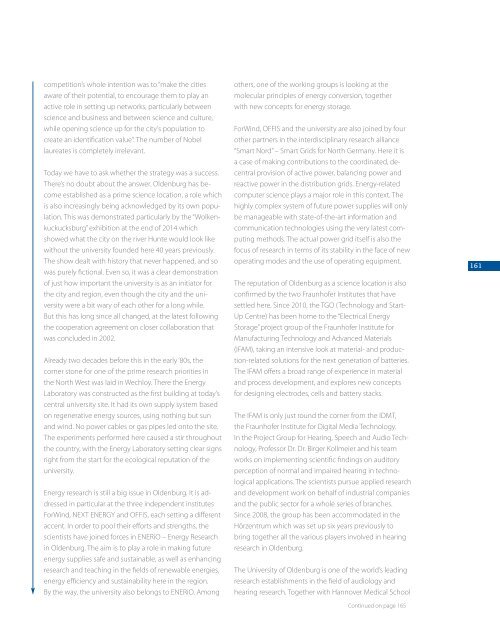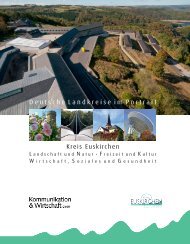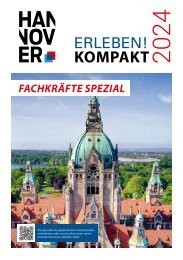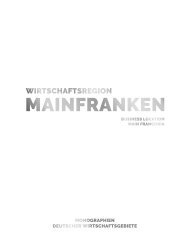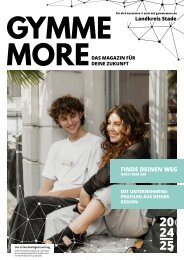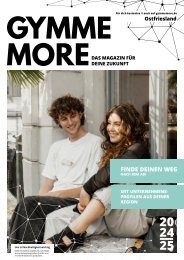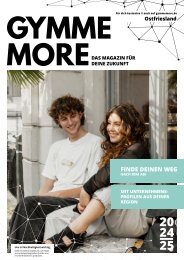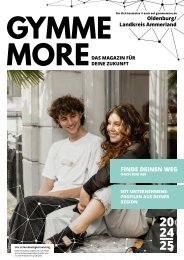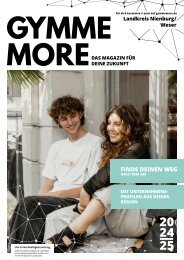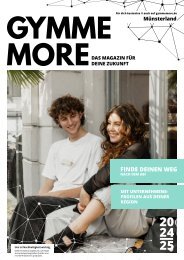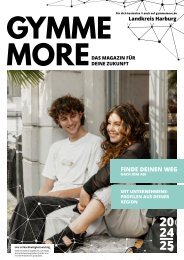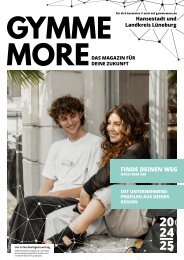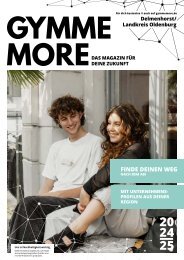Wirtschaftsstandort Oldenburg
Create successful ePaper yourself
Turn your PDF publications into a flip-book with our unique Google optimized e-Paper software.
competition’s whole intention was to “make the cities<br />
aware of their potential, to encourage them to play an<br />
active role in setting up networks, particularly between<br />
science and business and between science and culture,<br />
while opening science up for the city's population to<br />
create an identification value“. The number of Nobel<br />
laureates is completely irrelevant.<br />
Today we have to ask whether the strategy was a success.<br />
There’s no doubt about the answer. <strong>Oldenburg</strong> has become<br />
established as a prime science location, a role which<br />
is also increasingly being acknowledged by its own population.<br />
This was demonstrated particularly by the “Wolken -<br />
kuckucksburg” exhibition at the end of 2014 which<br />
showed what the city on the river Hunte would look like<br />
without the university founded here 40 years previously.<br />
The show dealt with history that never happened, and so<br />
was purely fictional. Even so, it was a clear demonstration<br />
of just how important the university is as an initiator for<br />
the city and region, even though the city and the uni -<br />
versity were a bit wary of each other for a long while.<br />
But this has long since all changed, at the latest following<br />
the cooperation agreement on closer collaboration that<br />
was concluded in 2002.<br />
Already two decades before this in the early ‘80s, the<br />
corner stone for one of the prime research priorities in<br />
the North West was laid in Wechloy. There the Energy<br />
Laboratory was constructed as the first building at today’s<br />
central university site. It had its own supply system based<br />
on regenerative energy sources, using nothing but sun<br />
and wind. No power cables or gas pipes led onto the site.<br />
The experiments performed here caused a stir throughout<br />
the country, with the Energy Laboratory setting clear signs<br />
right from the start for the ecological reputation of the<br />
university.<br />
Energy research is still a big issue in <strong>Oldenburg</strong>. It is addressed<br />
in particular at the three independent institutes<br />
ForWind, NEXT ENERGY and OFFIS, each setting a different<br />
accent. In order to pool their efforts and strengths, the<br />
scientists have joined forces in ENERiO – Energy Research<br />
in <strong>Oldenburg</strong>. The aim is to play a role in making future<br />
energy supplies safe and sustainable, as well as enhancing<br />
research and teaching in the fields of renewable energies,<br />
energy efficiency and sustainability here in the region.<br />
By the way, the university also belongs to ENERiO. Among<br />
others, one of the working groups is looking at the<br />
mo lecular principles of energy conversion, together<br />
with new concepts for energy storage.<br />
ForWind, OFFIS and the university are also joined by four<br />
other partners in the interdisciplinary research alliance<br />
“Smart Nord” – Smart Grids for North Germany. Here it is<br />
a case of making contributions to the coordinated, de -<br />
central provision of active power, balancing power and<br />
reactive power in the distribution grids. Energy-related<br />
computer science plays a major role in this context. The<br />
highly complex system of future power supplies will only<br />
be manageable with state-of-the-art information and<br />
communication technologies using the very latest computing<br />
methods. The actual power grid itself is also the<br />
focus of research in terms of its stability in the face of new<br />
operating modes and the use of operating equipment.<br />
The reputation of <strong>Oldenburg</strong> as a science location is also<br />
confirmed by the two Fraunhofer Institutes that have<br />
settled here. Since 2010, the TGO (Technology and Start-<br />
Up Centre) has been home to the “Electrical Energy<br />
Storage” project group of the Fraunhofer Institute for<br />
Manufacturing Technology and Advanced Materials<br />
(IFAM), taking an intensive look at material- and production-related<br />
solutions for the next generation of batteries.<br />
The IFAM offers a broad range of experience in material<br />
and process development, and explores new concepts<br />
for designing electrodes, cells and battery stacks.<br />
The IFAM is only just round the corner from the IDMT,<br />
the Fraunhofer Institute for Digital Media Technology.<br />
In the Project Group for Hearing, Speech and Audio Technology,<br />
Professor Dr. Dr. Birger Kollmeier and his team<br />
works on implementing scientific findings on auditory<br />
perception of normal and impaired hearing in techno -<br />
logical applications. The scientists pursue applied research<br />
and development work on behalf of industrial companies<br />
and the public sector for a whole series of branches.<br />
Since 2008, the group has been accommodated in the<br />
Hör zentrum which was set up six years previously to<br />
bring together all the various players involved in hearing<br />
research in <strong>Oldenburg</strong>.<br />
The University of <strong>Oldenburg</strong> is one of the world’s leading<br />
research establishments in the field of audiology and<br />
hearing research. Together with Hannover Medical School<br />
Continued on page 165<br />
161


